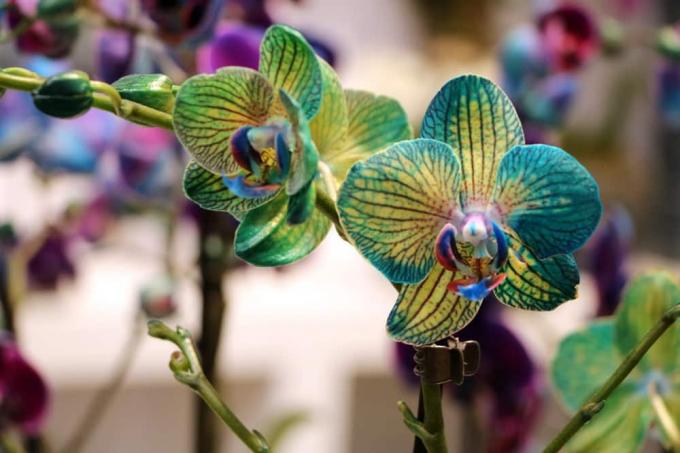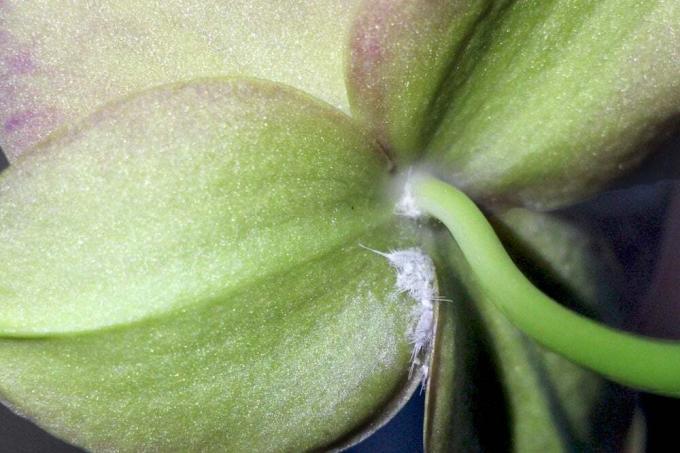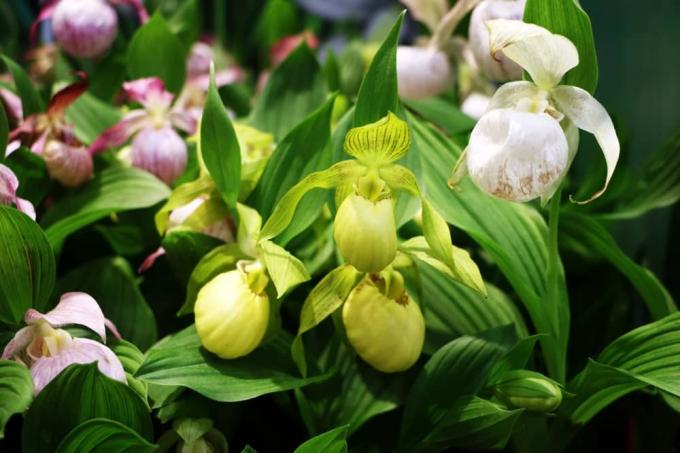

Table of contents
- Color cut flowers for the vase
- Experiments with colored water
- Change flower color with infusion
- Choosing the right material
- Color injection procedure
- Alternatives to artificial blue coloring
Flowers with an intense, blue hue are rather rare in nature, which is why they are all the more popular with garden lovers. Despite all breeding successes, no subspecies with permanently blue colored flowers have been able to establish themselves in orchids. But there are certainly tricks with which you can dye the flowers blue yourself.
Color cut flowers for the vase
Dyeing white orchid flowers to an extraordinary shade of blue works in a similar way to the procedure often used for dyeing tulips or roses: The flowers that have been cut off are simply placed with their stalks in colored water, whereupon the flowers gradually change color to a greater or lesser extent adjusts For example, blue ink or water-soluble food coloring can be used for this coloring method. The dosage of the dye in the water of the flower vase has a significant effect on the achievable color of the flowers dyed in this way.
Experiments with colored water
Dyeing living orchids is unfortunately not quite as easy as dyeing flowers that have already been cut off. Last but not least, this may also be due to the fact that orchids absorb very little liquid at all via earth roots. If you use this method to remove any blue discoloration of orchid blossoms that have been treated in the long term can be achieved, this is at most selective and only to a weak extent and intensity observe. Since orchids are generally quite sensitive, they can sometimes die irretrievably if there is a large dose of blue writing ink or other dyes in the irrigation water.
Change flower color with infusion
The "cheating" with the flowers is usually very easy to prove in the particularly impressive bright blue flowering specimens of the Phalaenopsis (butterfly orchid) in specialist shops. Simply look for a blue colored puncture site along the flower stalk or check the aerial roots for a gradual blue coloration. Both clues are clear indications for the infusion method, which was developed by a Dutch orchid grower: Dazu a special dye is injected directly into the pathways inside the flower stalk of an orchid using an injection needle injected.

From there, the dye (blue in most cases) gradually spreads through the fluid circulation within the plant into the various areas of the plant, with white flowers being particularly “susceptible” to the visibility of the color so incorporated are. In principle, all colors can be used in this way to change the color of a white flowering orchid species. In practice, however, shades of blue are preferred, since other flower colors such as pink or yellow can also be grown naturally and thus permanently color-stable.
Tip:
If you want to dye an orchid blue using the infusion method, you should choose a specimen with fresh, unflowered buds. Experience has shown that far better results can then be achieved with the blue coloring than with infusion into the pathways of already flowering specimens.
Choosing the right material
Blue ink is not suitable as a dye for the infusion method on orchids, as it will clog the pores of the delicate orchids when it dries. Special dyes such as the brilliant blue FCF "E133" are usually difficult to obtain, which is why despite the less strong coloring effect, water-soluble food coloring can be used should. You will also need the following accessories to turn orchids blue using the infusion method:
- a syringe with an injection needle about 1.5 mm to 2 mm thick
- possibly. an infusion container for the dye
- Rubber rings for temporarily fixing the infusion
- Cinnamon for wound care
You can obtain the necessary utensils from the pharmacy. It is important to select an appropriate hypodermic needle: thicker needles would constrict the pathways in the flower stalk Phalaenopsis unnecessarily badly hurt, while thinner needles again problems related to the thickness of the staining solution can cause.
Color injection procedure
First of all, the selected orchid should have a white or at least rather light flower color. A few days before the color injection, the selected plant should no longer be watered and only sprayed with a little water. Then go for the blue coloring of the flowers with the injection or infusion method as follows:
Dissolve the water-soluble food coloring in a cup of soft, room-temperature water
Fill the syringe with the color solution or fill it into the infusion container
Choose an inconspicuous (poorly visible) spot near the base of the plant for the injection site
Insert the hypodermic needle very carefully into the center of the flower stalk
Be careful not to puncture the flower stalk
Insert the needle into the stalk at an angle and attach the syringe to it with a rubber ring
Apply gentle pressure to the syringe or drip in the color solution from the IV bag several times a day
Seal and disinfect the wound with some ground cinnamon

In order to achieve a strongly perceptible effect of the blue color, a constant supply of color over a longer period of time is necessary. Forcing a large amount of paint into a Phalaenopsis at once can result in the death of the plant. Clearly visible results should be observed after just a few hours if the procedure is correct. In principle, this dyeing method must also be repeated after the flowers have died, so that blue orchid flowers can develop again in the following year.
Alternatives to artificial blue coloring
Orchid species with naturally blue-colored flowers are also available in specialist shops. However, these are not just orchid species that are difficult to care for, such as Vanda coerulea and Cattleya Portia coerulea, but also a much weaker and thus more subtle blue coloration of the Blossoms. In the meantime, however, breeders can also point to initial successes in the genetically influenced new breeding of blue-flowering orchid species. The three downsides:
- the corresponding new breeds are not yet commercially available
- this is probably due to a weaker blue coloring of the flowers
- the crossing of demanding orchid species results in a higher maintenance requirement than with butterfly orchids (Phalaenopsis)
However, the question also arises as to whether uncomplicated availability is of course bluer Orchids don't exactly have the "charm of the special" that these plants still have at the moment would nullify. In this respect, the artificial blue coloring of orchids is still an interesting gimmick for the moment Orchid lovers, as long as the elaborately bred, bright blue flowering species are not yet available as everyday goods in garden centers arrived.
 garden editorial
garden editorial I write about everything that interests me in my garden.
Learn more about orchid species

Fight pests on orchids - ways against lice & vermin
Orchids are popular indoor plants and are often given as gifts, but unfortunately they are also occasionally attacked by pests - and these can cause considerable damage to the plants. Interested parties can find out here how pests on orchids can be combated.

Cypripedium Orchids - Caring for Hardy Lady's Slippers
The exotic plant is a real eye-catcher and, with its unusual flowers, provides the extravagant touch in the home garden. However, if you want to enjoy the beautiful flowers from May, you need a little finesse when it comes to care.

Orchid has withered leaves - this is how you get them fit again
A healthy orchid usually has few but fleshy and lush green leaves. When they start to wither, the shock is great at first. Can the orchid still be saved? Read what your orchid is missing and what you can do about it.

Orchid location above the heating - is heating air harmful?
Many orchid species are native to subtropical and tropical climates. They need light, warmth - and high humidity. Conditions that do not exist in winter and in a place above a heater. With these measures, you can still get your orchids healthy through the cold season.

Native orchids: 8 wild varieties in the garden and forest
No way orchids only thrive in the tropics! They even exist in Antarctica - and of course here too. In fact, a wide range of wild orchid plants can be found in our forests and gardens. Learn more here.

orchid fertilizer vs. Home remedies - which fertilizer is the best?
Orchids are not known as divas among houseplants for nothing, but they are still very popular. They are very demanding when it comes to maintenance. The fertilizer is of particular importance, because the wrong fertilizer can cause a lot of damage.



